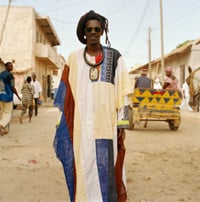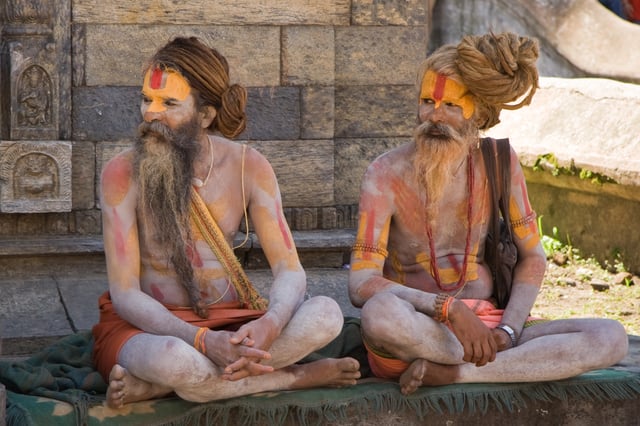Dreadlocks

Dreadlocks
Origins
![Young boxers with long dreadlocks depicted on a fresco from Akrotiri (modern Santorini, Greece) 1600–1500 BCE.*Combat%20Sports%20in%20th]]*Combat%20Sports%20in%20th]]*Combat%20Sports%20in%20th]]*Combat%20Sports%20in%20th]]Combat%20Sports%20in%20th]]]]](https://everipedia.org/cdn-cgi/image/width=640/https://upload.wikimedia.org/wikipedia/commons/e/e2/NAMA_Akrotiri_2.jpg)
Young boxers with long dreadlocks depicted on a fresco from Akrotiri (modern Santorini, Greece) 1600–1500 BCE.[3]*Combat%20Sports%20in%20th]]*Combat%20Sports%20in%20th]]*Combat%20Sports%20in%20th]]*Combat%20Sports%20in%20th]]Combat%20Sports%20in%20th]]]]
Some of the earliest depictions of dreadlocks date back as far as 3600 years to the Minoan Civilization, one of Europe's earliest civilizations, centered in Crete (now part of Greece).[4] Frescoes discovered on the Aegean island of Thera (modern Santorini, Greece) depict individuals with braided hair styled in long dreadlocks.[3]*Combat%20Sports%20in%20th]]*Combat%20Sports%20in%20th]]*Combat%20Sports%20in%20th]]*Combat%20Sports%20in%20th]]Combat%20Sports%20in%20th]]
In ancient Egypt, examples of Egyptians wearing locked hairstyles and wigs have appeared on bas-reliefs, statuary and other artifacts.[6] Mummified remains of ancient Egyptians with locked wigs have also been recovered from archaeological sites.[7]
During the Bronze Age and Iron Age many peoples in the Near East, Asia Minor, Caucasus, East Mediterranean and North Africa such as the Sumerians, Elamites, and Ancient Egyptians were depicted in art with braided or plaited hair and beards.[8][9][10]
History
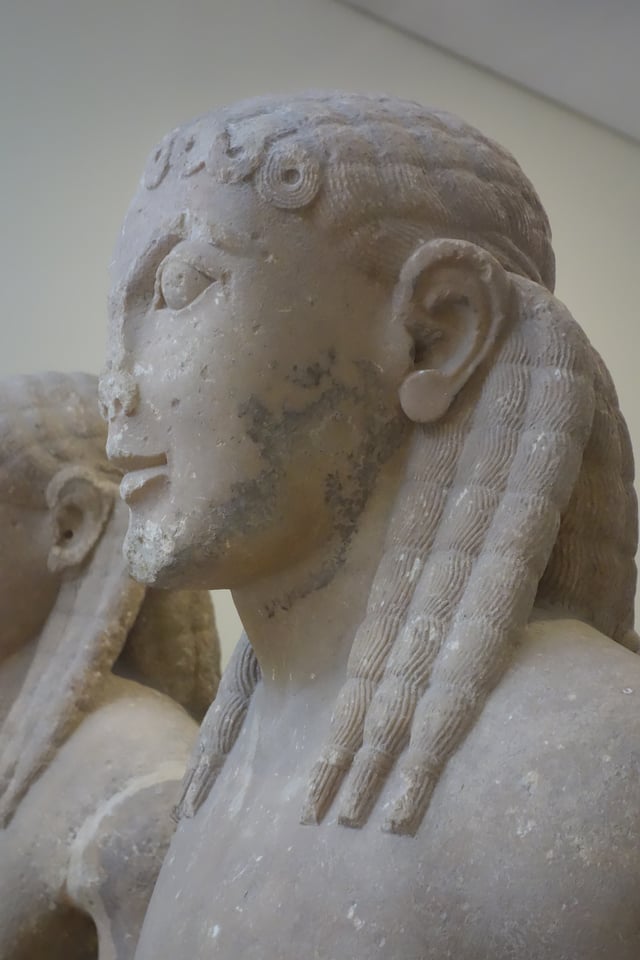
Over half of surviving Ancient Greek kouroi sculptures (from c. 615 – 485 BC) are found wearing dreadlocks.[11]
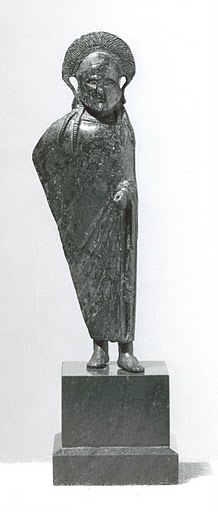
A Spartan officer depicted with locked hair.
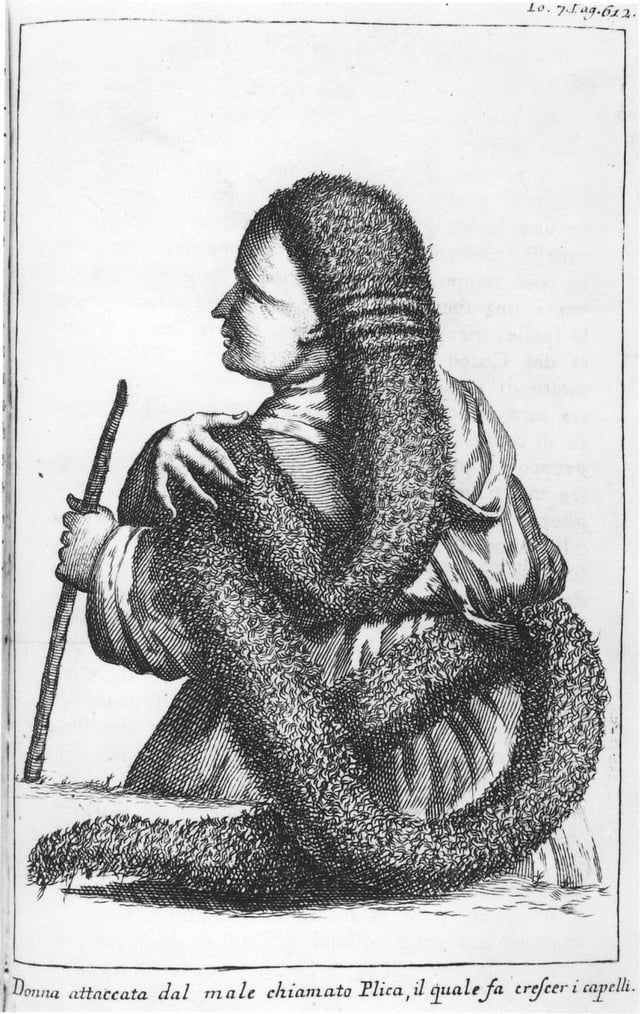
Polish plait, 1734-1766.
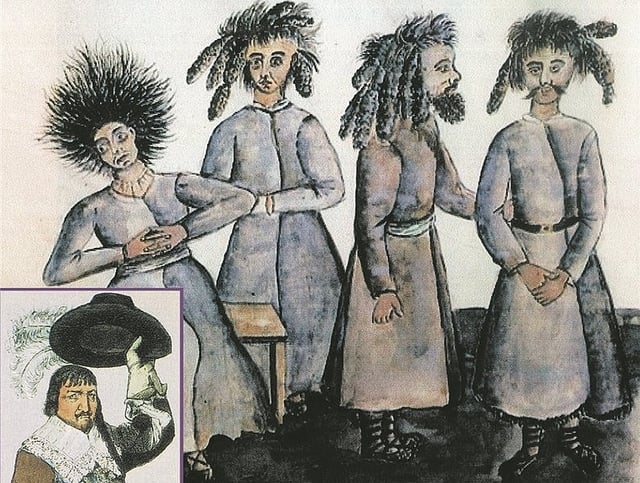
A drawing of Peasants with "Polish Plaits"
In Ancient Greece, kouros sculptures from the archaic period depict men wearing dreadlocks[11][12] while Spartan hoplites[13] wore formal locks as part of their battle dress.[14] Spartan magistrates known as Ephors also wore their hair braided in long locks, an Archaic Greek tradition that was steadily abandoned in other Greek kingdoms.[15]
The style was worn by Ancient Christian Ascetics in the Middle East and Mediterranean, and the Dervishes of Islam, among others.[16] Some of the very earliest adherents of Christianity in the Middle East may have worn this hairstyle; there are descriptions of James the Just, first Bishop of Jerusalem, who is said to have worn them to his ankles.[17]
here were priests with long robes of black cloth...
The hair of these priests was very long and so matted that it could not be separated or disentangled, and most of them had their ears scarified, and their hair was clotted with blood.
In Senegal, the Baye Fall, followers of the Mouride movement, a Sufi movement of Islam founded in 1887 AD by Shaykh Aamadu Bàmba Mbàkke, are famous for growing locks and wearing multi-colored gowns.[19] Cheikh Ibra Fall, founder of the Baye Fall school of the Mouride Brotherhood, popularized the style by adding a mystic touch to it. Warriors among the Fulani, Wolof and Serer in Mauritania, and Mandinka in Mali and Niger were known for centuries to have worn cornrows when young and dreadlocks when old. Larry Wolff in his book Inventing Eastern Europe: The Map of Civilization on the Mind of Enlightenment mentions that in Poland, for about a thousand years, some people wore a matted hair style similar to that of some Scythians. Zygmunt Gloger in his Encyklopedia staropolska mentions that the Polish plait (plica polonica) hair style was worn by some people of both genders in the Pinsk region and the Masovia region at the beginning of the 19th century. The Polish Plait can vary between one large plait and multiple plaits that resemble dreadlocks.[20]
By culture
Locks have been worn for various reasons in each culture.
Their use has also been raised in debates about cultural appropriation. [21]
Africa
Members of various African ethnic groups wear locks, the styles and significance of which may differ from one group to another.
Maasai warriors are famous for their long, thin, red locks, often dyed with red root extracts or red ochre. In Nigeria, some children are born with naturally locked hair and are given a special name: "Dada".[22] Yoruba priests of Olokun, the Orisha of the deep ocean, wear locks. In Ghana, the Akan refer to dreadlocks as Mpɛsɛ, which is the hairstyle of Akomfoɔ or priests and even common people. Along with the Asante-Akan drums known as Kete drums, this hairstyle was later adopted by Rastafarians, with roots in Jamaica from the slave trade era.
Australia
Historically, many indigenous Australians of North West and North Central Australia wore their hair in a locked style, sometimes also having long beards that were fully or partially locked. Some wore the locks loose, while others wrapped the locks around their heads, or bound them at the back of the head.[23]*The%20Customs%20And%20Traditi]]*The%20Customs%20And%20Traditi]]*The%20Customs%20And%20Traditi]]*The%20Customs%20And%20Traditi]]*The%20Customs%20And%20Traditi]]*n North Central Australia, the locks were often greased with fat and coated with red ochre, which assisted in their formation.
Hinduism
Hindu Vedic scriptures provide the earliest known evidence of dreadlocks.
Locks are worn in India by Sadhus or Holy men.
The Nagas are ascetics and followers of the god Shiva.
They wear their Jaata (locks) above their head and let them down only for special occasions and rituals.
Jaata means twisted locks of hair.
Indian holy men and women regard locks as sacred, considered to be a religious practice and an expression for their disregard of vanity.
Buddhism
Within Tibetan Buddhism and other more esoteric forms of Buddhism, dreadlocks have occasionally been substituted for the more traditional shaved head. The most recognizable of these groups are known as the Ngagpas of Tibet. For many practicing Buddhists, dreadlocks are a way to let go of material vanity and excessive attachments.[25] Dreadlocks were required for many esoteric Buddhist rituals in medieval South Asia performed by Buddhist yogis (Buddhist counterparts to contemporary Hindu sadhus). For instance, 1.4.15 of the Hevajratantra states that the practitioner "should arrange his piled up hair".[26] In contemporary Tibetan practice matted hair is replaced by crowns with matted hair attached to them.
Rastafari
Rastafari movement locks are symbolic of the Lion of Judah which is sometimes centered on the Ethiopian flag. Rastafari hold that Haile Selassie is a direct descendant of King Solomon and the Queen of Sheba, through their son Menelik I. Their dreadlocks were inspired by the Nazarites of the Bible.[27]
The cultivation of dreadlocks in the later Rastafari movement established a closer connection between the movement and the ideology it espoused.
It also gave the appearance, if not the substance, of greater authority.[28]
When reggae music espousing Rastafarian ideals gained popularity and mainstream acceptance in the 1970s thanks to Bob Marley's music and cultural influence, the locks (often called "dreads") became a notable fashion statement worldwide; they have been worn by prominent authors, actors, athletes and rappers.
In sports
Dreadlocks have become a popular hairstyle among professional athletes, ranging from Larry Fitzgerald's dreads down to his back to Drew Gooden's facial dreadlocks.
In professional American football, the number of players with dreadlocks has increased ever since Al Harris and Ricky Williams first wore the style during the 1990s. In 2012, about 180 National Football League players wore dreadlocks. A significant number of these players are defensive backs, who are less likely to be tackled than offensive players.[29] Players with very long dreadlocks have been tackled by their hair, which is legal according to NFL rules.
In the NBA there has been controversy over the Brooklyn Nets guard Jeremy Lin, an Asian-American who garnered mild controversy over his choice of dreadlocks. Former NBA player Kenyon Martin accused Lin of appropriating African-American culture in a since-deleted social media post. [30]
In western fashion
American people have developed a large variety of ways to wear dreadlocked also for hair. elements of these styles include the flat-twist, in which a section of locks are rolled together flat against the scalp to create an effect similar to the cornrows, and braided dreadlocks. Examples include flat-twisted half-back styles, flat-twisted mohawk styles, braided buns and braid-outs (or lock crinkles).
Locked models have appeared at fashion shows, and Rasta clothing with a Jamaican-style reggae look was sold.
Even exclusive fashion brands like Christian Dior created whole Rasta-inspired collections worn by models with a variety of lock hairstyles.
With dreadlocks style in vogue, the fashion and beauty industries capitalized on the trend.
A completely new line of hair care products and services in salons offer all sorts of dreadlock hair care items such as wax (considered unnecessary and even harmful by many),[31] shampoo, and jewelry.
Hairstylists created a wide variety of modified locks, including multi-colored synthetic lock hair extensions and "dread perms", where chemicals are used to treat the hair.
On July 3, 2019, California became the first US state to prohibit discrimination over natural hair.
Governor Gavin Newsom signed the CROWN Act into law, banning employers and schools from discriminating against hairstyles such as dreadlocks, braids, afros, and twists.[32] Likewise, later in 2019 Assembly Bill 07797 became law in New York state; it "prohibits race discrimination based on natural hair or hairstyles."[33]
In Western counterculture
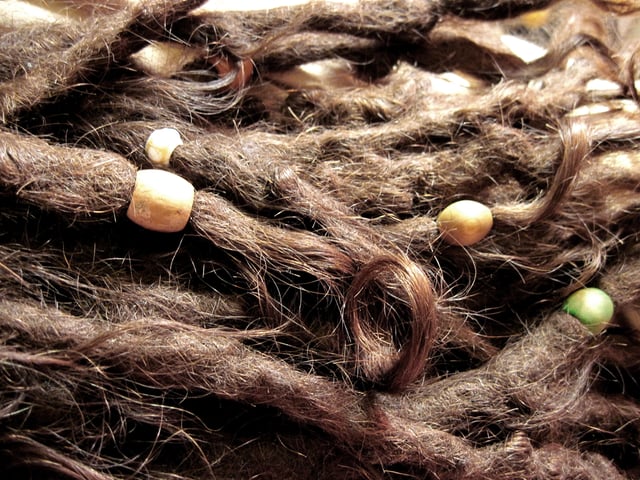
Hippie dreadlocks decorated with beads
In the West, since gatherings of hippies became common in the 1970s, dreadlocks have gained popularity among Caucasian, counterculture adherents such as hippies, crust punks, New Age travellers, goths and many members of the Rainbow Family.[34][35] Members of the cybergoth subculture also often wear synthetic dreads or "dreadfalls" made of synthetic hair, fabric or plastic tubing.[36]
Methods of making dreadlocks

Fully matured dreadlocks started from the comb twist method.
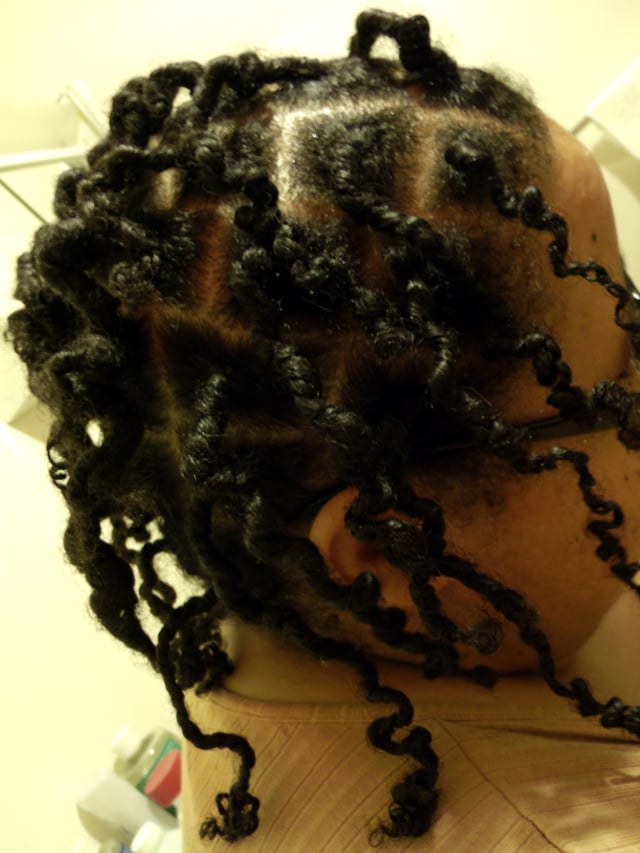
Newly twisted dreadlocks immediately after being unwound from Bantu knots; the locks later uncoiled and may thicken as matting progresses
Traditionally, it was believed that in order to create dreadlocks in non afro-textured hair, an individual had to refrain from brushing, combing or cutting.
This lack of hair grooming results in what is called "free form" or "neglect" dreads, where the hair matts together slowly of its own accord.
Such dreads tend to vary greatly in size, width, shape, length, and texture.
If the wearer is interested in any uniformity of their dreads, they must pull the matted strands of hair apart to ensure large clumps don't form.
All that is needed alongside the regular separating of sections is regular washing; oily dirty hair will slide along each other and never form knots.
Some people will spray a water solution with added sea salt and essential oils to dry the hair and accelerate the matting process.
A variety of other starter methods have been developed to offer greater control over the general appearance of dreadlocks.
They can be formed through a technique called "twist and rip", as well as backcombing interlocking and palm rolling.[37] Together, these alternative techniques are more commonly referred to as "salon" or "manicured" dreadlocks.[38]
Using beeswax to make dreads can cause problems because it does not wash out, due to the high melting point of natural wax.
Because wax is a hydrocarbon, water alone, no matter how hot, will not be able to remove wax.[39] This is often where problems like mold and dread rot come from, the wax clogs inside the length of the dread meaning water can't run out easily.
Having wet dreads for long periods of time helps mildew set in, this combined with the wax and every dirt/dust/fluff particle that has stuck to the wax can result in moldy, slimy dreads.
As with the organic and freeform method, the salon methods rely on hair naturally matting over a period of months to gradually form dreadlocks.
The difference is in the initial technique by which loose hair is encouraged to form a rope-like shape.
Whereas freeform dreadlocks can be created by simply refraining from combing or brushing hair and occasionally separating matted sections, salon dreadlocks use tool techniques to form the basis of the starter, immature set of dreadlocks.
A "matured" set of salon dreadlocks won't look the same as a set of dreadlocks that have been started with neglect or freeform.
For African hair types, salon dreadlocks can be formed by evenly sectioning and styling the loose hair into braids, coils, twists, or using a procedure called dread perming specifically used for straight hair. For European, Indigenous American, Asian, and Indian hair types, backcombing and twist and rip[37] are some of the more popular methods of achieving starter dreadlocks.
Regardless of hair type or texture and starter method used, dreadlocks require time before they are fully matured.
The process hair goes through as it develops into matured dreadlocks is continuous.
There is also the ability to adopt different types of fake dreadlocks that may make the hair look as real as possible.
This process is called synthetic dreadlocks.
There are two different types of synthetic dreadlocks.
The first is dread extensions, in which other hair can be infused with the wearer's own hair.
The second is dreadfalls, in which one dread is tied into another with either elastic or lace.
Both of these methods are used to make dreads look better and more appealing, and to achieve the desired effect of longer hair.
Guinness Book of World Records
On December 10, 2010, the Guinness Book of World Records
Following a review of our guidelines for the longest dreadlock, we have taken expert advice and made the decision to rest this category.
The reason for this is that it is difficult, and in many cases impossible, to measure the authenticity of the locks due to expert methods employed in the attachment of hair extensions/re-attachment of broken off dreadlocks.
Effectively the dreadlock can become an extension and therefore impossible to adjudicate accurately.
It is for this reason Guinness World Records has decided to rest the category and will no longer be monitoring the category for longest dreadlock.[40]
See also
Box braids
Rastacap
Elflock
Cornrows
French Braid
